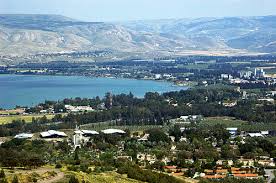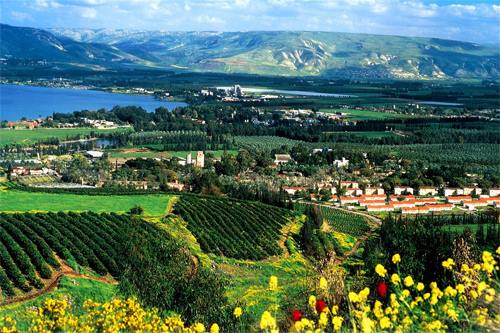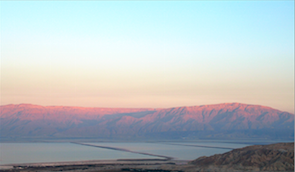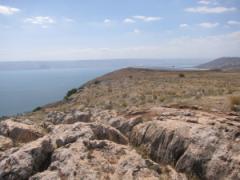Kinneret - Sea of Galillee - כנרת
The shores of Kinneret ooze with history. It's not uncommon to step on Roman pillars when you're wading in the Kinneret. So very enchanting, especially at sunup and sundown. 
The Kinneret has been valued for as long as humans have inhabited the area. The earliest human remains found in Israel were excavated nearby, and the many artifacts of ancient civilizations discovered in the area attest to its importance as a center of civilizations throughout the course of history. It is located in the Jordan Rift Valley, where the African and Arabian plates meet. The Egyptian Via Maris, the passageway from Egypt to its Northern Kingdoms, passed by. The lake is mentioned in the Old Testament (in the Books of Numbers and Joshua) as the Kinneret - it is believed that the name is derived from the Hebrew word for harp, a "kinor" - Hebrew for the Sea of Galilee - as if it were the name of their long-lost love.
Here, there has always been a Jewish presence for over 2000 years.When Jews were expelled from Jerusalem by the Romans, many fled to the area around the Kinneret, building up the fledging town of Tiberias. This population included a large number of the great rabbis of the times who wrote the Jerusalem Talmud while sitting along the shores of the Kinneret, referring to it in the Talmud as the Sea of Tiberias. Tiberias continued to maintain a small Jewish community throughout the centuries, and when Jewish settlement was revived in Israel in the late 1800s, the area around Lake Kinneret was one of the first places that the Zionist movement began agricultural endeavors in Israel. The first kibbutzim, communal settlements, were established along the lake's shores.
Traditions of Debate at Kibbutz Kinneret

“There’s something in that heroic story of the beginning that fulfilled a purpose over the years.” Yael Tzur
“The people of Kinneret are the best at everything. We’ll argue over everything,” says Amiram Idelman, 66, is a member of Kinneret and a tour guide specializing in the poet Rachel, the musician Naomi Shemer (both of Kinneret), and settlement in the Jordan Valley. “In the Kinneret DNA there are a number of very strong chromosomes, one of which is that it lives on the pride of the debate,” Idelman says. “If there’s nothing to argue about, we’ll find something, but woe to anyone who says something bad about Kinneret.”
One of the famous arguments was whether to send a young woman by the name of Naomi Sapir (eventually Naomi Shemer) to study music. Only at the fourth community meeting did she get approval.
One of the most prominent debaters was Aharon Shidlovsky, one of the first members of the kibbutz, who lived a Spartan life and fought for his principles, according to the researcher Moti Zeira. For example, in the 1970s he said that if a tourist business opened on the banks of the Jordan River, he would launch a hunger strike and leave the kibbutz. “I didn’t come to live in Israel to sell soda. Wait until I die,” he asked the kibbutz secretariat at the time. The project was indeed frozen and was established a year after Shidlovsky passed away.
Their obstinacy was so well known that pioneering labor leader Berl Katznelson coined a phrase for it: “sacred stubbornness.”
It is in the historic Kinneret Cemetery where many pioneers and leaders of the Labour movement are buried, among them Berl Katznelson, Nachman Syrkin, Rachel Bluwstein, Ber Borochov, Moses Hess, Avraham Herzfeld and Shmuel Stoller. The first grave was dug in 1911 and the cemetery continues to be a site for tourists to come pay tribute to our brothers and sisters who helped to settle the area and whose legacy continues until today.






